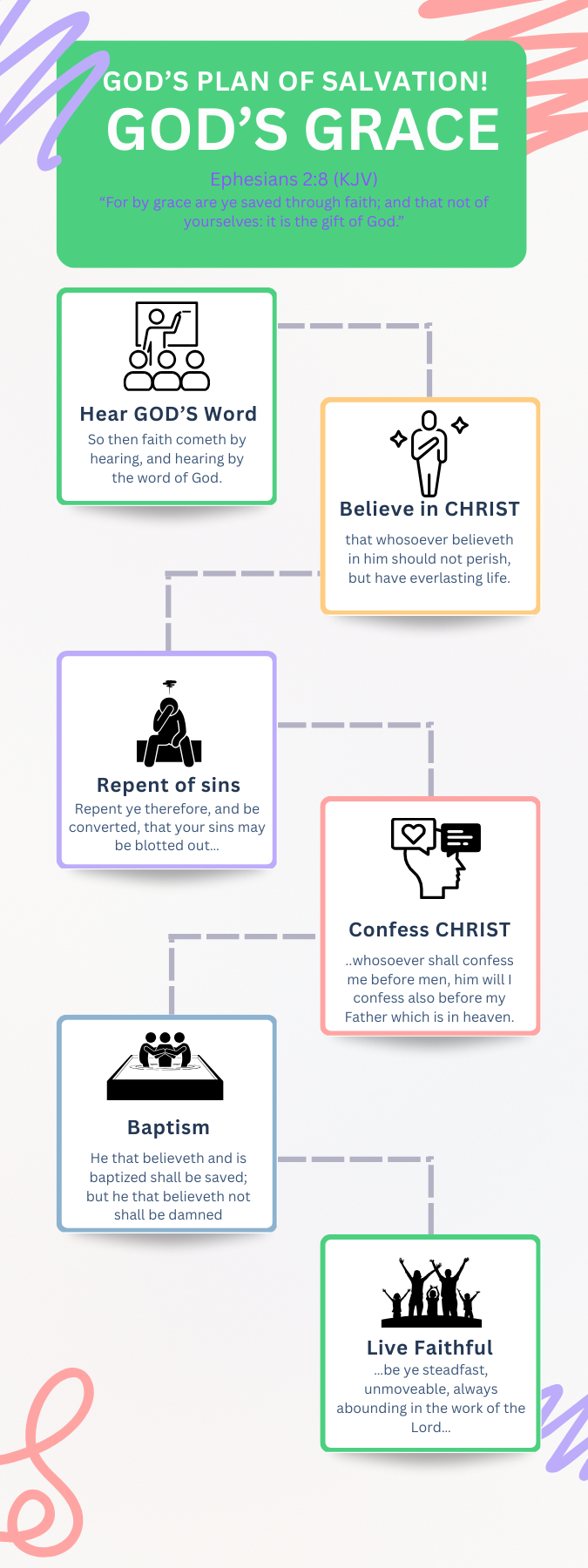What We Learn from the Video
The Bible’s full truth transforms lives, but partial teachings mislead. In “I Was Taught the Bible—But Not the Whole Truth,” the speaker thought their church’s Bible readings meant truth. Yet, they “skipped over key verses, like Acts 2.38 and Mark 16.16.” Reading for themselves revealed the truth about baptism and the complete gospel.
The video’s message is clear: the Bible plan of salvation requires obedience, not selective teaching. Acts 2:38 commands baptism for forgiveness, and Mark 16:16 ties belief and baptism to salvation. The speaker saw “obedience, baptism, repentance, and faith all matter.” Their church avoided these, offering partial truth. This led the speaker to embrace the full gospel plan of salvation.
The New Testament plan of salvation—hear, believe, repent, confess, baptize—unites us with Christ’s church. The speaker’s discovery urges us to read Scripture ourselves, not trust churches blindly. Are you following the whole gospel or a partial version? The speaker’s obedience brought clarity.
Don’t settle for half-truths. The truth about baptism is in Acts and Mark, not human doctrines. Study the Bible to find the Bible way to be saved. Like the speaker, seek the full gospel for eternal life in Christ’s church. This video challenges you to open your Bible and act on its complete truth today.
Why We Should Believe the Bible
The Bible is the ultimate authority, as the speaker in “I Was Taught the Bible—But Not the Whole Truth” learned. Their church skipped “key verses, like Acts 2.38 and Mark 16.16,” but personal study revealed the trustworthiness of Scripture. Here’s why the Bible, not selective teachings, holds the authority of the Bible.
Fulfilled Prophecy
Scripture’s predictions, like Micah 5:2 foretelling Jesus’ Bethlehem birth, came true centuries later. This accuracy proves God’s Word is truth. The speaker’s discovery of Acts 2:38 confirmed Scripture’s reliability over their church’s omissions.
Historical Accuracy
Archaeological finds, like the Pilate Stone, verify biblical figures and events. Acts aligns with historical records, giving confidence in its accounts. The speaker trusted Mark 16:16, finding baptism’s role in salvation.
Eyewitness Testimony
The New Testament is built on firsthand accounts. 1 Corinthians 15:6 notes, “Then he appeared to more than five hundred brothers at one time.” These witnesses convinced the speaker to obey Acts 2:38, not partial teachings.
Divine Inspiration
2 Timothy 3:16 declares, “All Scripture is breathed out by God.” Its unity across authors and eras shows divine guidance. The speaker saw “the full picture” in Scripture, not their church’s selective readings.
The authority of the Bible is unmatched. It’s God’s complete revelation, unlike the speaker’s church, which avoided “the hard stuff.” Don’t trust partial sermons. Read the Bible yourself to find the truth about baptism and the Bible way to be saved. Let Scripture guide you to eternal life in Christ’s church, as the speaker’s obedience proves.
How to Apply This Truth to My Life
The video’s call to embrace the “full picture” of the gospel—“obedience, baptism, repentance, and faith all matter”—urges us to apply God’s Word. The speaker’s church skipped Acts 2:38, but personal study led to obedience. Here are five steps for Christian living through obedience to the gospel.
Step 1: Study the Full Bible
Read Acts 2:38 and Mark 16:16 daily. The speaker found truth by reading “for myself.” Use a Bible app or join a study group to uncover the truth about baptism.
Step 2: Question Church Teachings
Does your church teach the whole gospel? The speaker’s church avoided “key verses.” Compare sermons to Scripture to ensure alignment with the gospel plan of salvation.
Step 3: Obey the Gospel
Follow the Bible’s plan: hear, believe, repent, confess, baptize (Acts 2:38). The speaker embraced “the whole gospel.” Contact a church of Christ for baptism guidance.
Step 4: Join Christ’s Church
Seek the church of Christ (Romans 16:16), which teaches the full gospel. The speaker’s obedience led to clarity. Attend a congregation focused on the New Testament plan of salvation.
Step 5: Share the Full Truth
Tell others about baptism and obedience. The speaker’s story inspires sharing Mark 16:16, promoting Christian living for eternal life.
Real-Life Example: Lisa’s church read the Bible weekly, but skipped baptism’s purpose. After watching the video, she studies Acts 2:38 and is baptized biblically, joining the church of Christ. Her obedience to the gospel brings peace, replacing confusion.
By applying these steps, you embrace the Bible way to be saved. Let God’s Word guide your Christian living, as the speaker did, for salvation in Christ’s church.
What This Denomination Teaches about Salvation
The speaker in “I Was Taught the Bible—But Not the Whole Truth” was misled by their church’s selective teachings, which “skipped over key verses, like Acts 2.38 and Mark 16.16.” This reflects a Baptist perspective, where salvation focuses on faith rather than baptism’s role. Let’s respectfully examine the Baptist denominational view of salvation, based on research from sources like the Southern Baptist Convention, and contrast it with the New Testament, as the speaker’s discovery of the “full picture” highlights.
Salvation by Faith Alone
Baptists teach that salvation is through faith alone in Jesus Christ. It’s a personal decision to trust Jesus as Savior, receiving forgiveness by grace. Ephesians 2:8-9 is foundational: “For by grace you have been saved through faith… not of works.” The speaker’s church likely emphasized this, prioritizing belief over obedience, which led to skipping verses like Acts 2:38. This view sees salvation as an inward change, independent of rituals.
Role of the Sinner’s Prayer
The sinner’s prayer is often central in Baptist soteriology. Believers pray to confess sins and accept Jesus, marking salvation. Romans 10:13 is cited: “Everyone who calls upon the name of the Lord will be saved.” The speaker’s church, reading the Bible weekly but avoiding “the hard stuff,” likely focused on this prayer, sidelining baptism’s purpose in forgiveness.
Water Baptism Meaning
Baptists view the water baptism meaning as a symbolic act of obedience. It’s immersion for believers, representing Christ’s death and resurrection (Romans 6:4), but not essential for salvation. The speaker’s church skipped Mark 16:16, implying baptism is a testimony post-salvation, not for forgiveness. This aligns with Baptist rejection of regenerative baptism, unlike some sacramental traditions.
Repentance and Confession
Repentance is a heartfelt turn from sin, paired with confession of faith. Romans 10:9 states: “If you confess with your mouth that Jesus is Lord… you will be saved.” These steps typically precede the sinner’s prayer, but the speaker’s church omitted baptism’s role, focusing on faith and confession alone.
Role of the Church
Baptists see the church as a community of believers, where baptism signifies membership. Salvation is individual, not tied to specific acts like baptism for forgiveness. The speaker’s church read the Bible but avoided “key verses,” reflecting this emphasis on personal faith over unified obedience.
Differences from New Testament
While respecting Baptist sincerity, their denominational view of salvation diverges from Scripture. Acts 2:38 commands: “Repent and be baptized… for the forgiveness of your sins.” Baptism is essential for remission (1 Peter 3:21: “Baptism… now saves you”). The sinner’s prayer lacks biblical precedent; salvation requires belief and baptism (Mark 16:16). Acts 2:47 shows the saved are added to Christ’s church through baptism, not as a membership rite. The speaker’s realization—“partial truth isn’t enough”—highlights this. The New Testament’s unified plan contrasts Baptist omission of baptism’s necessity, as seen in Acts 2:38 and Romans 6. For the truth about salvation, obey the full gospel for eternal life in Christ.
What the Bible Teaches about Salvation
The Bible’s complete plan of salvation transformed the speaker in “I Was Taught the Bible—But Not the Whole Truth.” Their church skipped “key verses, like Acts 2.38 and Mark 16.16,” but personal study revealed: “Obedience, baptism, repentance, and faith all matter.” This Bible way to be saved led to the “whole gospel.” The New Testament plan of salvation answers, “What must I do to be saved?” (Acts 16:30), guiding us to forgiveness. Let’s explore each step with practical, persuasive explanations.
Step 1: Hearing the Word
Salvation begins with hearing God’s Word. Romans 10:17 states: “So faith comes from hearing, and hearing through the word of Christ.” Without hearing, truth remains hidden.
The speaker read “for myself” and found the full gospel. Practically, read Acts daily or listen to audio Bibles. Join a church of Christ study group. Why persuasive? Hearing corrects errors, like the speaker’s church skipping Acts 2:38. It ignites faith, turning confusion to clarity. This step is essential for the gospel plan of salvation.
Step 2: Believing in Jesus
Hearing leads to belief. Mark 16:16 declares: “Whoever believes and is baptized will be saved, but whoever does not believe will be condemned.” Belief trusts Jesus’ sacrifice for sins.
John 3:16 adds: “For God so loved the world, that he gave his only Son, that whoever believes in him should not perish but have eternal life.” The speaker believed but missed the full plan until reading. Practically, study prophecies like Psalm 22. Pray for conviction. Why persuasive? Belief offers hope, as the speaker’s obedience showed. It drives repentance.
Step 3: Repentance from Sin
Belief requires repentance. Acts 2:38 commands: “Repent and be baptized every one of you in the name of Jesus Christ for the forgiveness of your sins.” Repentance turns from sin.
Luke 13:3 warns: “Unless you repent, you will all likewise perish.” The speaker repented of partial teachings. Practically, list sins—pride, dishonesty—and change habits. Seek accountability. Why persuasive? Repentance frees guilt (Acts 3:19), like a wrong path corrected. It prepares for confession.
Step 4: Confession of Faith
Repentance leads to confession. Romans 10:9-10 explains: “If you confess with your mouth that Jesus is Lord and believe in your heart that God raised him from the dead, you will be saved.”
Matthew 10:32 promises: “Everyone who acknowledges me before men, I also will acknowledge before my Father who is in heaven.” The speaker confessed by obeying the full gospel. Practically, declare publicly. Why persuasive? Confession solidifies faith, securing God’s promise. It leads to baptism.
Step 5: Baptism for Remission of Sins
Baptism is the moment of forgiveness. Acts 2:38 ties it to repentance. 1 Peter 3:21 affirms: “Baptism, which corresponds to this, now saves you… as an appeal to God for a good conscience.”
The truth about baptism is immersion for salvation. Romans 6:3-4 states: “We were buried therefore with him by baptism into death… so we too might walk in newness of life.” The speaker saw “obedience, baptism, repentance, and faith all matter.” Practically, contact a church of Christ for immersion. Why persuasive? Baptism washes sins (Acts 22:16). Galatians 3:27 says: “For as many of you as were baptized into Christ have put on Christ.” The Ethiopian obeyed quickly (Acts 8:36-38). Baptism adds to the church (Acts 2:47), unlike partial teachings.
Step 6: Living Faithfully
Salvation demands faithfulness. Revelation 2:10 urges: “Be faithful unto death, and I will give you the crown of life.” This is enduring obedience.
Hebrews 10:36 says: “You have need of endurance, so that when you have done the will of God you may receive what is promised.” The speaker wanted “the whole gospel.” Practically, worship, study, serve. Pray through trials. Why persuasive? Faithfulness secures reward (James 1:12). It completes the plan for eternal life.
The Bible’s steps—hear, believe, repent, confess, baptize, endure—offer unity. Ephesians 4:5 affirms “one baptism.” The speaker’s story warns against partial truth.
Heartfelt Appeal: Beloved, don’t settle for half-truths. Read Acts 2:38, obey the full gospel, and find peace in Christ. Act now for eternal joy.
Background of the Denomination
The speaker in “I Was Taught the Bible—But Not the Whole Truth” was misled by their Baptist church, which “skipped over key verses, like Acts 2.38 and Mark 16.16.” Understanding the history of the Baptist denomination and the origin of Baptist teachings clarifies why such omissions occur. Here’s a factual overview of the Baptist denomination’s beginnings and core doctrines, with ties to their salvation teachings.
Origins and Founding
The Baptist denomination emerged in the early 17th century from English Separatists seeking religious freedom. John Smyth, a key figure, founded the first Baptist church in Amsterdam around 1609, rejecting infant baptism for believer’s baptism by immersion. In 1638, Roger Williams established the first Baptist church in America in Providence, Rhode Island. The origin of Baptist teachings emphasizes personal faith and scriptural authority, reacting against Church of England practices.
Formation of the Southern Baptist Convention
In 1845, Southern Baptists split from Northern Baptists over slavery, forming the Southern Baptist Convention (SBC) in Augusta, Georgia. William Bullein Johnson drafted its constitution, focusing on missions. This split influenced salvation teachings, as Southern Baptists prioritized individual conversion and baptism as a symbolic act, not essential for forgiveness, aligning with the speaker’s experience of selective teaching.
Core Doctrines
Baptist beliefs include soul competency (individual responsibility before God), salvation by grace through faith alone, believer’s baptism by immersion, and church autonomy. The Baptist Faith and Message (2000) affirms salvation through faith, with baptism as a public testimony, not a saving act. The speaker’s church reflected this, avoiding Acts 2:38’s emphasis on baptism for forgiveness.
Historical Events and Salvation Teachings
The 1845 split shaped Baptist soteriology. Southern Baptists, tied to Southern culture, emphasized the sinner’s prayer and faith alone, as seen in the speaker’s partial teachings. The 1995 SBC resolution on racial reconciliation acknowledged past errors but didn’t alter salvation doctrine. The speaker’s discovery of “the full picture”—baptism’s role—contrasts with Baptist focus on personal faith over obedience.
The history of the Baptist denomination shows a commitment to individual faith but a divergence from New Testament baptism teachings. The speaker’s journey to the truth about salvation reflects a need to study Scripture fully for eternal life.
Key Bible Passages to Read and Study
The speaker in “I Was Taught the Bible—But Not the Whole Truth” found clarity by reading “key verses, like Acts 2.38 and Mark 16.16.” These Bible verses about salvation reveal the New Testament plan of salvation. Below are ten verses, with explanations, to guide your study for Scriptures for eternal life.
Acts 2:38
“Repent and be baptized every one of you in the name of Jesus Christ for the forgiveness of your sins.”
This verse, skipped by the speaker’s church, commands repentance and baptism for forgiveness, central to the gospel plan of salvation.
Mark 16:16
“Whoever believes and is baptized will be saved, but whoever does not believe will be condemned.”
The speaker discovered this verse links belief and baptism to salvation, showing baptism’s necessity.
Romans 10:17
“So faith comes from hearing, and hearing through the word of Christ.”
Faith begins with hearing God’s Word, the first step in salvation, urging us to study Scripture.
John 3:16
“For God so loved the world, that he gave his only Son, that whoever believes in him should not perish but have eternal life.”
Belief in Jesus is foundational, offering eternal life, as the speaker learned.
Acts 3:19
“Repent therefore, and turn back, that your sins may be blotted out.”
Repentance, turning from sin, is required for forgiveness, aligning with the speaker’s call for obedience.
Romans 10:9
“If you confess with your mouth that Jesus is Lord and believe in your heart that God raised him from the dead, you will be saved.”
Confession declares faith publicly, a step toward salvation.
1 Peter 3:21
“Baptism, which corresponds to this, now saves you… as an appeal to God for a good conscience.”
This affirms the truth about baptism as essential for salvation, not a symbol.
Romans 6:3-4
“We were buried therefore with him by baptism into death… so we too might walk in newness of life.”
Baptism unites us with Christ’s death and resurrection, as the speaker’s “full picture” revealed.
Galatians 3:27
“For as many of you as were baptized into Christ have put on Christ.”
Baptism brings us into Christ, ensuring salvation and church membership.
Revelation 2:10
“Be faithful unto death, and I will give you the crown of life.”
Faithful living secures eternal life, completing the Bible way to be saved.
These Scriptures for eternal life outline the gospel plan—hear, believe, repent, confess, baptize, endure. The speaker’s church omitted some, but studying them brought truth. Read these verses to embrace the truth about salvation for peace in Christ’s church.
Common Misunderstandings about Salvation
The speaker in “I Was Taught the Bible—But Not the Whole Truth” was misled by their church’s selective teachings, which “skipped over key verses, like Acts 2.38 and Mark 16.16.” These omissions reflect false teachings about salvation common in some denominations, including Baptist churches. Below, five misconceptions about grace are explained, corrected with Scripture, and tied to the speaker’s realization that “partial truth isn’t enough.”
Error 1: Faith Only Saves
Many believe salvation comes through faith alone, without further obedience. The speaker’s church emphasized belief, skipping baptism’s role in Acts 2:38. This assumes faith is sufficient without action.
James 2:24 corrects: “You see that a person is justified by works and not by faith alone.” The speaker learned “obedience, baptism, repentance, and faith all matter.” Faith requires baptism and repentance for the truth about salvation.
Error 2: Baptism Is Optional or Symbolic
Some view baptism as a symbolic ritual, not essential for salvation. The speaker’s church avoided Mark 16:16, teaching baptism as a post-salvation act, aligning with Baptist doctrine.
Acts 2:38 refutes: “Repent and be baptized… for the forgiveness of your sins.” The truth about baptism is its necessity for remission, as the speaker discovered, not a mere testimony.
Error 3: Saved Before Baptism
This error claims salvation occurs at faith or through a sinner’s prayer, with baptism as a formality. The speaker’s church skipped “key verses” like Acts 2:38, implying salvation precedes baptism.
1 Peter 3:21 clarifies: “Baptism… now saves you… as an appeal to God for a good conscience.” The speaker’s study revealed “the full picture”—baptism is where sins are forgiven.
Error 4: Universalism—All Are Saved
Universalism teaches everyone will be saved, regardless of obedience, due to God’s love. This dismisses specific steps like baptism, which the speaker’s church avoided.
Matthew 7:13-14 counters: “Enter by the narrow gate… the way is hard that leads to life, and those who find it are few.” The speaker’s obedience to “the whole gospel” shows salvation requires the gospel plan of salvation.
Error 5: Once Saved, Always Saved
Some believe salvation is permanent, even if one falls away. The speaker’s church focused on faith, ignoring ongoing obedience.
Hebrews 6:4-6 warns: “For it is impossible, in the case of those who have once been enlightened… and then have fallen away, to restore them again to repentance.” The speaker’s commitment to the full gospel emphasizes faithfulness for eternal life.
These misconceptions about grace misled the speaker until Scripture revealed the truth about baptism. Acts 2:38 and Mark 16:16 transformed their understanding. Obey the New Testament plan of salvation for assurance in Christ’s church.
Real-Life Examples of Changed Lives
The Christian testimony of those who obey the gospel, as seen in “I Was Taught the Bible—But Not the Whole Truth,” shows its transformative power. The speaker’s church “skipped over key verses, like Acts 2.38 and Mark 16.16,” but their study revealed: “Obedience, baptism, repentance, and faith all matter.” Embracing the full gospel changed their life. Below are two testimonies reflecting this changed life through the gospel.
Testimony 1: Anna’s Journey to Truth
Anna, raised Baptist, thought weekly Bible readings meant truth. Her church emphasized faith but never taught baptism’s role in forgiveness. After watching the video, she read Acts 2:38: “Repent and be baptized… for the forgiveness of your sins.” Realizing her baptism was symbolic, Anna was re-baptized into the church of Christ. Her doubts turned to peace, and she now leads Bible studies, sharing the truth about baptism. Her Christian testimony mirrors the speaker’s, finding assurance in the New Testament plan of salvation.
Testimony 2: James’ Discovery of the Gospel
James attended a Baptist church, believing he was saved through faith alone. Sermons avoided baptism’s purpose, like the speaker’s experience. Studying Mark 16:16—“Whoever believes and is baptized will be saved”—changed his perspective. James was baptized biblically, joining the church of Christ. His changed life through the gospel brought clarity, and he now encourages friends to study Acts 2:38. Like the speaker, James found joy in the “whole gospel.”
These stories echo the speaker’s shift from partial truth to obedience. Anna and James followed the gospel—hear, believe, repent, confess, baptize—entering Christ’s church (Acts 2:47). Their lives show the gospel’s power to replace confusion with confidence. The Bible way to be saved offers peace through obedience, not selective teachings. Like the speaker, their obedience to the full gospel brought unshakable assurance, proving that only the whole truth leads to eternal life.
Why Urgency Matters in Responding to the Gospel
The urgency of salvation is critical, as shown in “I Was Taught the Bible—But Not the Whole Truth.” The speaker’s church “skipped over key verses, like Acts 2.38 and Mark 16.16,” delaying their understanding until they read for themselves. Their obedience to the “whole gospel” brought peace. Do not delay obeying the gospel—waiting risks eternity. Here’s why today is the day to act.
Life’s Brevity Demands Action
Life is unpredictable. James 4:14 warns: “You do not know what tomorrow will bring. What is your life? For you are a mist that appears for a little time and then vanishes.” The speaker could have missed salvation by relying on partial teachings. Acting now ensures forgiveness through the truth about baptism.
God’s Call Is Immediate
Scripture demands prompt response. 2 Corinthians 6:2 states: “Behold, now is the favorable time; behold, now is the day of salvation.” The speaker’s delay, due to skipped verses, shows the risk of waiting. Acts 22:16 urges: “And now why do you wait? Rise and be baptized and wash away your sins.” Obeying the gospel plan of salvation today secures eternal life.
Delay Risks Spiritual Hardening
Postponing can dull your heart. Hebrews 3:13 advises: “Exhort one another every day… that none of you may be hardened by the deceitfulness of sin.” The speaker’s church avoided “the hard stuff,” but personal study led to obedience. Immediate action prevents clinging to error.
Eternal Consequences of Waiting
Hesitation has high stakes. Matthew 7:21 warns: “Not everyone who says to me, ‘Lord, Lord,’ will enter the kingdom of heaven, but the one who does the will of my Father.” The speaker’s realization that “partial truth isn’t enough” drove them to act. Don’t miss the New Testament plan of salvation.
Practical Steps to Act Now
Start today: Read Acts 2:38 and Mark 16:16. Contact a church of Christ for baptism guidance. Join a Bible study to learn the Bible way to be saved. The speaker’s obedience “changed everything.” Pray for courage; reject selective teachings. Do not delay obeying the gospel.
Why Act Immediately?
Psalm 95:7-8 pleads: “Today, if you hear his voice, do not harden your hearts.” The speaker’s story—embracing “obedience, baptism, repentance, and faith”—shows urgency. The gospel plan—hear, believe, repent, confess, baptize—offers assurance. Galatians 3:27 says: “For as many of you as were baptized into Christ have put on Christ.” Act now for peace in Christ’s church.
The urgency of salvation is clear. Don’t wait, misled by partial truths like the speaker. Obey the full gospel today for eternal life.
Questions to Ask Yourself After Watching
The video “I Was Taught the Bible—But Not the Whole Truth” challenges us to examine our faith. The speaker’s church “skipped over key verses, like Acts 2.38 and Mark 16.16,” but studying revealed: “Obedience, baptism, repentance, and faith all matter.” To reflect on your eternal destiny, here are six questions probing the Bible truth about salvation.
Question 1: Am I Saved by God’s Plan?
Have I followed the Bible’s steps—hear, believe, repent, confess, baptize—for forgiveness (Acts 2:38)? Or am I trusting partial teachings, like the speaker’s church?
Question 2: Does My Baptism Align with Scripture?
Was my baptism for remission of sins, per Acts 2:38? The speaker learned “partial truth isn’t enough.” Does my baptism reflect the truth about baptism?
Question 3: Am I Relying on Scripture or Tradition?
Does my church teach the full gospel, or avoid “the hard stuff”? Am I trusting sermons over God’s Word?
Question 4: Am I in Christ’s Church?
Am I part of the church of Christ (Romans 16:16)? Or does my church follow selective doctrines, missing the gospel plan of salvation?
Question 5: Have I Obeyed Fully?
Have I completed all gospel steps (Mark 16:16)? The speaker embraced the “whole gospel.” Do I need to obey biblically?
Question 6: Am I Faithful for Eternity?
Am I enduring in faith (Revelation 2:10) for eternal life? Or do I need to recommit to the Bible truth about salvation?
These questions mirror the speaker’s journey to the New Testament plan of salvation. Am I saved by Scripture’s standard? Reflect—your eternal destiny depends on obeying the full gospel for assurance.
Next Steps for Learning More
The speaker’s transformation in “I Was Taught the Bible—But Not the Whole Truth”—realizing “obedience, baptism, repentance, and faith all matter”—urges action. Acts 2:38 and Mark 16:16 revealed the “whole gospel.” To learn how to be saved, follow these steps for a changed life through the gospel.
Join a Free Bible Study
Enroll in a free Bible study at a church of Christ. Study Acts 2:38 and Mark 16:16 to grasp the truth about baptism. The speaker read “for myself.” Visit AreUSaved.com for local or online studies to explore the gospel plan of salvation.
Dive into AreUSaved.com articles on baptism and salvation. These clarify the New Testament plan of salvation, as the speaker learned. Regular reading ensures alignment with Scripture for eternal life.
Questions about the gospel? Use the AreUSaved.com chatbot at https://AreUSaved.com/contact. The speaker sought the “full picture.” Contact experts to discuss baptism or joining Christ’s church.
Obey the Gospel Today
Don’t wait. The speaker embraced the “whole gospel.” Follow the steps: hear, believe, repent, confess, baptize (Acts 2:38). Contact a church of Christ for immersion to obey the Bible way to be saved.
Share the Truth
Tell others about the full gospel. The speaker’s story inspires sharing Mark 16:16, promoting Christian living. Share AreUSaved.com resources to guide friends to truth.
Act now. Visit AreUSaved.com for a free Bible study, read articles, and contact the team at https://AreUSaved.com/contact. Obey the gospel for eternal life in Christ’s church.
What We Learn from the Video
The Bible’s full truth transforms lives, but partial teachings mislead. In “I Was Taught the Bible—But Not the Whole Truth,” the speaker thought their church’s Bible readings meant truth. Yet, they “skipped over key verses, like Acts 2.38 and Mark 16.16.” Reading for themselves revealed the truth about baptism and the complete gospel.
The video’s message is clear: the Bible plan of salvation requires obedience, not selective teaching. Acts 2:38 commands baptism for forgiveness, and Mark 16:16 ties belief and baptism to salvation. The speaker saw “obedience, baptism, repentance, and faith all matter.” Their church avoided these, offering partial truth. This led the speaker to embrace the full gospel plan of salvation.
The New Testament plan of salvation—hear, believe, repent, confess, baptize—unites us with Christ’s church. The speaker’s discovery urges us to read Scripture ourselves, not trust churches blindly. Are you following the whole gospel or a partial version? The speaker’s obedience brought clarity.
Don’t settle for half-truths. The truth about baptism is in Acts and Mark, not human doctrines. Study the Bible to find the Bible way to be saved. Like the speaker, seek the full gospel for eternal life in Christ’s church. This video challenges you to open your Bible and act on its complete truth today.
Why We Should Believe the Bible
The Bible is the ultimate authority, as the speaker in “I Was Taught the Bible—But Not the Whole Truth” learned. Their church skipped “key verses, like Acts 2.38 and Mark 16.16,” but personal study revealed the trustworthiness of Scripture. Here’s why the Bible, not selective teachings, holds the authority of the Bible.
Fulfilled Prophecy
Scripture’s predictions, like Micah 5:2 foretelling Jesus’ Bethlehem birth, came true centuries later. This accuracy proves God’s Word is truth. The speaker’s discovery of Acts 2:38 confirmed Scripture’s reliability over their church’s omissions.
Historical Accuracy
Archaeological finds, like the Pilate Stone, verify biblical figures and events. Acts aligns with historical records, giving confidence in its accounts. The speaker trusted Mark 16:16, finding baptism’s role in salvation.
Eyewitness Testimony
The New Testament is built on firsthand accounts. 1 Corinthians 15:6 notes, “Then he appeared to more than five hundred brothers at one time.” These witnesses convinced the speaker to obey Acts 2:38, not partial teachings.
Divine Inspiration
2 Timothy 3:16 declares, “All Scripture is breathed out by God.” Its unity across authors and eras shows divine guidance. The speaker saw “the full picture” in Scripture, not their church’s selective readings.
The authority of the Bible is unmatched. It’s God’s complete revelation, unlike the speaker’s church, which avoided “the hard stuff.” Don’t trust partial sermons. Read the Bible yourself to find the truth about baptism and the Bible way to be saved. Let Scripture guide you to eternal life in Christ’s church, as the speaker’s obedience proves.
How to Apply This Truth to My Life
The video’s call to embrace the “full picture” of the gospel—“obedience, baptism, repentance, and faith all matter”—urges us to apply God’s Word. The speaker’s church skipped Acts 2:38, but personal study led to obedience. Here are five steps for Christian living through obedience to the gospel.
Step 1: Study the Full Bible
Read Acts 2:38 and Mark 16:16 daily. The speaker found truth by reading “for myself.” Use a Bible app or join a study group to uncover the truth about baptism.
Step 2: Question Church Teachings
Does your church teach the whole gospel? The speaker’s church avoided “key verses.” Compare sermons to Scripture to ensure alignment with the gospel plan of salvation.
Step 3: Obey the Gospel
Follow the Bible’s plan: hear, believe, repent, confess, baptize (Acts 2:38). The speaker embraced “the whole gospel.” Contact a church of Christ for baptism guidance.
Step 4: Join Christ’s Church
Seek the church of Christ (Romans 16:16), which teaches the full gospel. The speaker’s obedience led to clarity. Attend a congregation focused on the New Testament plan of salvation.
Step 5: Share the Full Truth
Tell others about baptism and obedience. The speaker’s story inspires sharing Mark 16:16, promoting Christian living for eternal life.
Real-Life Example: Lisa’s church read the Bible weekly, but skipped baptism’s purpose. After watching the video, she studies Acts 2:38 and is baptized biblically, joining the church of Christ. Her obedience to the gospel brings peace, replacing confusion.
By applying these steps, you embrace the Bible way to be saved. Let God’s Word guide your Christian living, as the speaker did, for salvation in Christ’s church.
What This Denomination Teaches about Salvation
The speaker in “I Was Taught the Bible—But Not the Whole Truth” was misled by their church’s selective teachings, which “skipped over key verses, like Acts 2.38 and Mark 16.16.” This reflects a Baptist perspective, where salvation focuses on faith rather than baptism’s role. Let’s respectfully examine the Baptist denominational view of salvation, based on research from sources like the Southern Baptist Convention, and contrast it with the New Testament, as the speaker’s discovery of the “full picture” highlights.
Salvation by Faith Alone
Baptists teach that salvation is through faith alone in Jesus Christ. It’s a personal decision to trust Jesus as Savior, receiving forgiveness by grace. Ephesians 2:8-9 is foundational: “For by grace you have been saved through faith… not of works.” The speaker’s church likely emphasized this, prioritizing belief over obedience, which led to skipping verses like Acts 2:38. This view sees salvation as an inward change, independent of rituals.
Role of the Sinner’s Prayer
The sinner’s prayer is often central in Baptist soteriology. Believers pray to confess sins and accept Jesus, marking salvation. Romans 10:13 is cited: “Everyone who calls upon the name of the Lord will be saved.” The speaker’s church, reading the Bible weekly but avoiding “the hard stuff,” likely focused on this prayer, sidelining baptism’s purpose in forgiveness.
Water Baptism Meaning
Baptists view the water baptism meaning as a symbolic act of obedience. It’s immersion for believers, representing Christ’s death and resurrection (Romans 6:4), but not essential for salvation. The speaker’s church skipped Mark 16:16, implying baptism is a testimony post-salvation, not for forgiveness. This aligns with Baptist rejection of regenerative baptism, unlike some sacramental traditions.
Repentance and Confession
Repentance is a heartfelt turn from sin, paired with confession of faith. Romans 10:9 states: “If you confess with your mouth that Jesus is Lord… you will be saved.” These steps typically precede the sinner’s prayer, but the speaker’s church omitted baptism’s role, focusing on faith and confession alone.
Role of the Church
Baptists see the church as a community of believers, where baptism signifies membership. Salvation is individual, not tied to specific acts like baptism for forgiveness. The speaker’s church read the Bible but avoided “key verses,” reflecting this emphasis on personal faith over unified obedience.
Differences from New Testament
While respecting Baptist sincerity, their denominational view of salvation diverges from Scripture. Acts 2:38 commands: “Repent and be baptized… for the forgiveness of your sins.” Baptism is essential for remission (1 Peter 3:21: “Baptism… now saves you”). The sinner’s prayer lacks biblical precedent; salvation requires belief and baptism (Mark 16:16). Acts 2:47 shows the saved are added to Christ’s church through baptism, not as a membership rite. The speaker’s realization—“partial truth isn’t enough”—highlights this. The New Testament’s unified plan contrasts Baptist omission of baptism’s necessity, as seen in Acts 2:38 and Romans 6. For the truth about salvation, obey the full gospel for eternal life in Christ.
What the Bible Teaches about Salvation
The Bible’s complete plan of salvation transformed the speaker in “I Was Taught the Bible—But Not the Whole Truth.” Their church skipped “key verses, like Acts 2.38 and Mark 16.16,” but personal study revealed: “Obedience, baptism, repentance, and faith all matter.” This Bible way to be saved led to the “whole gospel.” The New Testament plan of salvation answers, “What must I do to be saved?” (Acts 16:30), guiding us to forgiveness. Let’s explore each step with practical, persuasive explanations.
Step 1: Hearing the Word
Salvation begins with hearing God’s Word. Romans 10:17 states: “So faith comes from hearing, and hearing through the word of Christ.” Without hearing, truth remains hidden.
The speaker read “for myself” and found the full gospel. Practically, read Acts daily or listen to audio Bibles. Join a church of Christ study group. Why persuasive? Hearing corrects errors, like the speaker’s church skipping Acts 2:38. It ignites faith, turning confusion to clarity. This step is essential for the gospel plan of salvation.
Step 2: Believing in Jesus
Hearing leads to belief. Mark 16:16 declares: “Whoever believes and is baptized will be saved, but whoever does not believe will be condemned.” Belief trusts Jesus’ sacrifice for sins.
John 3:16 adds: “For God so loved the world, that he gave his only Son, that whoever believes in him should not perish but have eternal life.” The speaker believed but missed the full plan until reading. Practically, study prophecies like Psalm 22. Pray for conviction. Why persuasive? Belief offers hope, as the speaker’s obedience showed. It drives repentance.
Step 3: Repentance from Sin
Belief requires repentance. Acts 2:38 commands: “Repent and be baptized every one of you in the name of Jesus Christ for the forgiveness of your sins.” Repentance turns from sin.
Luke 13:3 warns: “Unless you repent, you will all likewise perish.” The speaker repented of partial teachings. Practically, list sins—pride, dishonesty—and change habits. Seek accountability. Why persuasive? Repentance frees guilt (Acts 3:19), like a wrong path corrected. It prepares for confession.
Step 4: Confession of Faith
Repentance leads to confession. Romans 10:9-10 explains: “If you confess with your mouth that Jesus is Lord and believe in your heart that God raised him from the dead, you will be saved.”
Matthew 10:32 promises: “Everyone who acknowledges me before men, I also will acknowledge before my Father who is in heaven.” The speaker confessed by obeying the full gospel. Practically, declare publicly. Why persuasive? Confession solidifies faith, securing God’s promise. It leads to baptism.
Step 5: Baptism for Remission of Sins
Baptism is the moment of forgiveness. Acts 2:38 ties it to repentance. 1 Peter 3:21 affirms: “Baptism, which corresponds to this, now saves you… as an appeal to God for a good conscience.”
The truth about baptism is immersion for salvation. Romans 6:3-4 states: “We were buried therefore with him by baptism into death… so we too might walk in newness of life.” The speaker saw “obedience, baptism, repentance, and faith all matter.” Practically, contact a church of Christ for immersion. Why persuasive? Baptism washes sins (Acts 22:16). Galatians 3:27 says: “For as many of you as were baptized into Christ have put on Christ.” The Ethiopian obeyed quickly (Acts 8:36-38). Baptism adds to the church (Acts 2:47), unlike partial teachings.
Step 6: Living Faithfully
Salvation demands faithfulness. Revelation 2:10 urges: “Be faithful unto death, and I will give you the crown of life.” This is enduring obedience.
Hebrews 10:36 says: “You have need of endurance, so that when you have done the will of God you may receive what is promised.” The speaker wanted “the whole gospel.” Practically, worship, study, serve. Pray through trials. Why persuasive? Faithfulness secures reward (James 1:12). It completes the plan for eternal life.
The Bible’s steps—hear, believe, repent, confess, baptize, endure—offer unity. Ephesians 4:5 affirms “one baptism.” The speaker’s story warns against partial truth.
Heartfelt Appeal: Beloved, don’t settle for half-truths. Read Acts 2:38, obey the full gospel, and find peace in Christ. Act now for eternal joy.
Background of the Denomination
The speaker in “I Was Taught the Bible—But Not the Whole Truth” was misled by their Baptist church, which “skipped over key verses, like Acts 2.38 and Mark 16.16.” Understanding the history of the Baptist denomination and the origin of Baptist teachings clarifies why such omissions occur. Here’s a factual overview of the Baptist denomination’s beginnings and core doctrines, with ties to their salvation teachings.
Origins and Founding
The Baptist denomination emerged in the early 17th century from English Separatists seeking religious freedom. John Smyth, a key figure, founded the first Baptist church in Amsterdam around 1609, rejecting infant baptism for believer’s baptism by immersion. In 1638, Roger Williams established the first Baptist church in America in Providence, Rhode Island. The origin of Baptist teachings emphasizes personal faith and scriptural authority, reacting against Church of England practices.
Formation of the Southern Baptist Convention
In 1845, Southern Baptists split from Northern Baptists over slavery, forming the Southern Baptist Convention (SBC) in Augusta, Georgia. William Bullein Johnson drafted its constitution, focusing on missions. This split influenced salvation teachings, as Southern Baptists prioritized individual conversion and baptism as a symbolic act, not essential for forgiveness, aligning with the speaker’s experience of selective teaching.
Core Doctrines
Baptist beliefs include soul competency (individual responsibility before God), salvation by grace through faith alone, believer’s baptism by immersion, and church autonomy. The Baptist Faith and Message (2000) affirms salvation through faith, with baptism as a public testimony, not a saving act. The speaker’s church reflected this, avoiding Acts 2:38’s emphasis on baptism for forgiveness.
Historical Events and Salvation Teachings
The 1845 split shaped Baptist soteriology. Southern Baptists, tied to Southern culture, emphasized the sinner’s prayer and faith alone, as seen in the speaker’s partial teachings. The 1995 SBC resolution on racial reconciliation acknowledged past errors but didn’t alter salvation doctrine. The speaker’s discovery of “the full picture”—baptism’s role—contrasts with Baptist focus on personal faith over obedience.
The history of the Baptist denomination shows a commitment to individual faith but a divergence from New Testament baptism teachings. The speaker’s journey to the truth about salvation reflects a need to study Scripture fully for eternal life.
Key Bible Passages to Read and Study
The speaker in “I Was Taught the Bible—But Not the Whole Truth” found clarity by reading “key verses, like Acts 2.38 and Mark 16.16.” These Bible verses about salvation reveal the New Testament plan of salvation. Below are ten verses, with explanations, to guide your study for Scriptures for eternal life.
Acts 2:38
“Repent and be baptized every one of you in the name of Jesus Christ for the forgiveness of your sins.”
This verse, skipped by the speaker’s church, commands repentance and baptism for forgiveness, central to the gospel plan of salvation.
Mark 16:16
“Whoever believes and is baptized will be saved, but whoever does not believe will be condemned.”
The speaker discovered this verse links belief and baptism to salvation, showing baptism’s necessity.
Romans 10:17
“So faith comes from hearing, and hearing through the word of Christ.”
Faith begins with hearing God’s Word, the first step in salvation, urging us to study Scripture.
John 3:16
“For God so loved the world, that he gave his only Son, that whoever believes in him should not perish but have eternal life.”
Belief in Jesus is foundational, offering eternal life, as the speaker learned.
Acts 3:19
“Repent therefore, and turn back, that your sins may be blotted out.”
Repentance, turning from sin, is required for forgiveness, aligning with the speaker’s call for obedience.
Romans 10:9
“If you confess with your mouth that Jesus is Lord and believe in your heart that God raised him from the dead, you will be saved.”
Confession declares faith publicly, a step toward salvation.
1 Peter 3:21
“Baptism, which corresponds to this, now saves you… as an appeal to God for a good conscience.”
This affirms the truth about baptism as essential for salvation, not a symbol.
Romans 6:3-4
“We were buried therefore with him by baptism into death… so we too might walk in newness of life.”
Baptism unites us with Christ’s death and resurrection, as the speaker’s “full picture” revealed.
Galatians 3:27
“For as many of you as were baptized into Christ have put on Christ.”
Baptism brings us into Christ, ensuring salvation and church membership.
Revelation 2:10
“Be faithful unto death, and I will give you the crown of life.”
Faithful living secures eternal life, completing the Bible way to be saved.
These Scriptures for eternal life outline the gospel plan—hear, believe, repent, confess, baptize, endure. The speaker’s church omitted some, but studying them brought truth. Read these verses to embrace the truth about salvation for peace in Christ’s church.
Common Misunderstandings about Salvation
The speaker in “I Was Taught the Bible—But Not the Whole Truth” was misled by their church’s selective teachings, which “skipped over key verses, like Acts 2.38 and Mark 16.16.” These omissions reflect false teachings about salvation common in some denominations, including Baptist churches. Below, five misconceptions about grace are explained, corrected with Scripture, and tied to the speaker’s realization that “partial truth isn’t enough.”
Error 1: Faith Only Saves
Many believe salvation comes through faith alone, without further obedience. The speaker’s church emphasized belief, skipping baptism’s role in Acts 2:38. This assumes faith is sufficient without action.
James 2:24 corrects: “You see that a person is justified by works and not by faith alone.” The speaker learned “obedience, baptism, repentance, and faith all matter.” Faith requires baptism and repentance for the truth about salvation.
Error 2: Baptism Is Optional or Symbolic
Some view baptism as a symbolic ritual, not essential for salvation. The speaker’s church avoided Mark 16:16, teaching baptism as a post-salvation act, aligning with Baptist doctrine.
Acts 2:38 refutes: “Repent and be baptized… for the forgiveness of your sins.” The truth about baptism is its necessity for remission, as the speaker discovered, not a mere testimony.
Error 3: Saved Before Baptism
This error claims salvation occurs at faith or through a sinner’s prayer, with baptism as a formality. The speaker’s church skipped “key verses” like Acts 2:38, implying salvation precedes baptism.
1 Peter 3:21 clarifies: “Baptism… now saves you… as an appeal to God for a good conscience.” The speaker’s study revealed “the full picture”—baptism is where sins are forgiven.
Error 4: Universalism—All Are Saved
Universalism teaches everyone will be saved, regardless of obedience, due to God’s love. This dismisses specific steps like baptism, which the speaker’s church avoided.
Matthew 7:13-14 counters: “Enter by the narrow gate… the way is hard that leads to life, and those who find it are few.” The speaker’s obedience to “the whole gospel” shows salvation requires the gospel plan of salvation.
Error 5: Once Saved, Always Saved
Some believe salvation is permanent, even if one falls away. The speaker’s church focused on faith, ignoring ongoing obedience.
Hebrews 6:4-6 warns: “For it is impossible, in the case of those who have once been enlightened… and then have fallen away, to restore them again to repentance.” The speaker’s commitment to the full gospel emphasizes faithfulness for eternal life.
These misconceptions about grace misled the speaker until Scripture revealed the truth about baptism. Acts 2:38 and Mark 16:16 transformed their understanding. Obey the New Testament plan of salvation for assurance in Christ’s church.
Real-Life Examples of Changed Lives
The Christian testimony of those who obey the gospel, as seen in “I Was Taught the Bible—But Not the Whole Truth,” shows its transformative power. The speaker’s church “skipped over key verses, like Acts 2.38 and Mark 16.16,” but their study revealed: “Obedience, baptism, repentance, and faith all matter.” Embracing the full gospel changed their life. Below are two testimonies reflecting this changed life through the gospel.
Testimony 1: Anna’s Journey to Truth
Anna, raised Baptist, thought weekly Bible readings meant truth. Her church emphasized faith but never taught baptism’s role in forgiveness. After watching the video, she read Acts 2:38: “Repent and be baptized… for the forgiveness of your sins.” Realizing her baptism was symbolic, Anna was re-baptized into the church of Christ. Her doubts turned to peace, and she now leads Bible studies, sharing the truth about baptism. Her Christian testimony mirrors the speaker’s, finding assurance in the New Testament plan of salvation.
Testimony 2: James’ Discovery of the Gospel
James attended a Baptist church, believing he was saved through faith alone. Sermons avoided baptism’s purpose, like the speaker’s experience. Studying Mark 16:16—“Whoever believes and is baptized will be saved”—changed his perspective. James was baptized biblically, joining the church of Christ. His changed life through the gospel brought clarity, and he now encourages friends to study Acts 2:38. Like the speaker, James found joy in the “whole gospel.”
These stories echo the speaker’s shift from partial truth to obedience. Anna and James followed the gospel—hear, believe, repent, confess, baptize—entering Christ’s church (Acts 2:47). Their lives show the gospel’s power to replace confusion with confidence. The Bible way to be saved offers peace through obedience, not selective teachings. Like the speaker, their obedience to the full gospel brought unshakable assurance, proving that only the whole truth leads to eternal life.
Why Urgency Matters in Responding to the Gospel
The urgency of salvation is critical, as shown in “I Was Taught the Bible—But Not the Whole Truth.” The speaker’s church “skipped over key verses, like Acts 2.38 and Mark 16.16,” delaying their understanding until they read for themselves. Their obedience to the “whole gospel” brought peace. Do not delay obeying the gospel—waiting risks eternity. Here’s why today is the day to act.
Life’s Brevity Demands Action
Life is unpredictable. James 4:14 warns: “You do not know what tomorrow will bring. What is your life? For you are a mist that appears for a little time and then vanishes.” The speaker could have missed salvation by relying on partial teachings. Acting now ensures forgiveness through the truth about baptism.
God’s Call Is Immediate
Scripture demands prompt response. 2 Corinthians 6:2 states: “Behold, now is the favorable time; behold, now is the day of salvation.” The speaker’s delay, due to skipped verses, shows the risk of waiting. Acts 22:16 urges: “And now why do you wait? Rise and be baptized and wash away your sins.” Obeying the gospel plan of salvation today secures eternal life.
Delay Risks Spiritual Hardening
Postponing can dull your heart. Hebrews 3:13 advises: “Exhort one another every day… that none of you may be hardened by the deceitfulness of sin.” The speaker’s church avoided “the hard stuff,” but personal study led to obedience. Immediate action prevents clinging to error.
Eternal Consequences of Waiting
Hesitation has high stakes. Matthew 7:21 warns: “Not everyone who says to me, ‘Lord, Lord,’ will enter the kingdom of heaven, but the one who does the will of my Father.” The speaker’s realization that “partial truth isn’t enough” drove them to act. Don’t miss the New Testament plan of salvation.
Practical Steps to Act Now
Start today: Read Acts 2:38 and Mark 16:16. Contact a church of Christ for baptism guidance. Join a Bible study to learn the Bible way to be saved. The speaker’s obedience “changed everything.” Pray for courage; reject selective teachings. Do not delay obeying the gospel.
Why Act Immediately?
Psalm 95:7-8 pleads: “Today, if you hear his voice, do not harden your hearts.” The speaker’s story—embracing “obedience, baptism, repentance, and faith”—shows urgency. The gospel plan—hear, believe, repent, confess, baptize—offers assurance. Galatians 3:27 says: “For as many of you as were baptized into Christ have put on Christ.” Act now for peace in Christ’s church.
The urgency of salvation is clear. Don’t wait, misled by partial truths like the speaker. Obey the full gospel today for eternal life.
Questions to Ask Yourself After Watching
The video “I Was Taught the Bible—But Not the Whole Truth” challenges us to examine our faith. The speaker’s church “skipped over key verses, like Acts 2.38 and Mark 16.16,” but studying revealed: “Obedience, baptism, repentance, and faith all matter.” To reflect on your eternal destiny, here are six questions probing the Bible truth about salvation.
Question 1: Am I Saved by God’s Plan?
Have I followed the Bible’s steps—hear, believe, repent, confess, baptize—for forgiveness (Acts 2:38)? Or am I trusting partial teachings, like the speaker’s church?
Question 2: Does My Baptism Align with Scripture?
Was my baptism for remission of sins, per Acts 2:38? The speaker learned “partial truth isn’t enough.” Does my baptism reflect the truth about baptism?
Question 3: Am I Relying on Scripture or Tradition?
Does my church teach the full gospel, or avoid “the hard stuff”? Am I trusting sermons over God’s Word?
Question 4: Am I in Christ’s Church?
Am I part of the church of Christ (Romans 16:16)? Or does my church follow selective doctrines, missing the gospel plan of salvation?
Question 5: Have I Obeyed Fully?
Have I completed all gospel steps (Mark 16:16)? The speaker embraced the “whole gospel.” Do I need to obey biblically?
Question 6: Am I Faithful for Eternity?
Am I enduring in faith (Revelation 2:10) for eternal life? Or do I need to recommit to the Bible truth about salvation?
These questions mirror the speaker’s journey to the New Testament plan of salvation. Am I saved by Scripture’s standard? Reflect—your eternal destiny depends on obeying the full gospel for assurance.
Next Steps for Learning More
The speaker’s transformation in “I Was Taught the Bible—But Not the Whole Truth”—realizing “obedience, baptism, repentance, and faith all matter”—urges action. Acts 2:38 and Mark 16:16 revealed the “whole gospel.” To learn how to be saved, follow these steps for a changed life through the gospel.
Join a Free Bible Study
Enroll in a free Bible study at a church of Christ. Study Acts 2:38 and Mark 16:16 to grasp the truth about baptism. The speaker read “for myself.” Visit AreUSaved.com for local or online studies to explore the gospel plan of salvation.
Dive into AreUSaved.com articles on baptism and salvation. These clarify the New Testament plan of salvation, as the speaker learned. Regular reading ensures alignment with Scripture for eternal life.
Questions about the gospel? Use the AreUSaved.com chatbot at https://AreUSaved.com/contact. The speaker sought the “full picture.” Contact experts to discuss baptism or joining Christ’s church.
Obey the Gospel Today
Don’t wait. The speaker embraced the “whole gospel.” Follow the steps: hear, believe, repent, confess, baptize (Acts 2:38). Contact a church of Christ for immersion to obey the Bible way to be saved.
Share the Truth
Tell others about the full gospel. The speaker’s story inspires sharing Mark 16:16, promoting Christian living. Share AreUSaved.com resources to guide friends to truth.
Act now. Visit AreUSaved.com for a free Bible study, read articles, and contact the team at https://AreUSaved.com/contact. Obey the gospel for eternal life in Christ’s church.





































.png)


.png)
.png)
.png)










